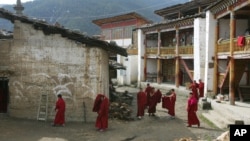Chinese government workers are dismantling buildings and evicting residents at Larung Gar, one of the world's largest centers of Tibetan Buddhist learning, according to overseas-based Tibetan groups, though a local official said the site was being renovated.
London-based Free Tibet said government workers began removing residential buildings and evicting people who live at the academy in western Sichuan province on Thursday morning. Several exile Tibetan groups have said local authorities distributed an order in June to reduce the number of monks and nuns living there by half to 5,000, citing overcrowding concerns.
The order also sought a clear separation between genuine monks and nuns studying at the site and lay people residing there, according to pro-Tibetan groups, which have characterized the government move as an attempt to better manage religious activity in the area.
A Sertar County government official said by telephone Thursday that police were not demolishing buildings but rather renovating them, but gave no further details. The official gave only her surname, Zhang, because she was not authorized to speak to the media. The county's press office was "not reachable'' on its telephone line on Friday, according to a recorded message.
Founded in 1980, the academy attracts Tibetan Buddhist monks and nuns for short- and long-term study in the religion's more esoteric aspects. They typically stay in a sprawling mountainside settlement made of thousands of log cabins.
Government teams previously evicted thousands of monks in 2001, but the site has swelled significantly in the years since.
Tsering Tsomo, director of the Tibetan Centre for Human Rights and Democracy in Dharamsala, India, said monastery leaders including the abbot Tsultrim Lodroe have opted to keep a low media profile while appealing for "restraint and sobriety'' among their followers for fear of escalating tensions with authorities.
"The gist of what they [monastery leaders] are calling for is to let the authorities proceed with the partial demolition, as it would only cause loss to some practitioners and their dwellings,'' Tsering said. "Because the continued survival of the Larung Gar itself is more important.''
The expulsions came on the day that China's hand-picked Panchen Lama, the second-highest figure in Tibetan Buddhism, presided over a four-day Buddhist ritual called the Kalachakra initiation at his home monastery in southwestern Tibet. It was the first time the ritual was carried out in Tibet in 50 years and attracted 50,000 Buddhists, according to the official Xinhua news agency.
Tibetan groups this week condemned the ceremony as a sham orchestrated by Beijing to assert its authority. China picked its own Panchen Lama in 1995, rejecting a boy chosen by the Dalai Lama, Tibetan Buddhism's highest ranking figure, who lives in exile in India and is regarded by Beijing as a separatist.




